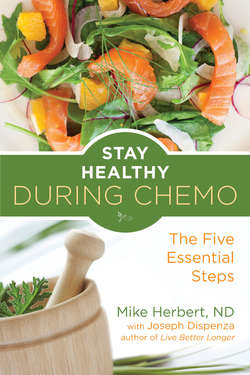Читать книгу Stay Healthy During Chemo - Джо Диспенза - Страница 12
На сайте Литреса книга снята с продажи.
What Chemo Is Designed to Do
ОглавлениеTo understand more about what really goes on in chemo treatment, it is important to know what chemotherapy is designed to do. Chemotherapy treats cancer with an antineoplastic drug or several antineoplastic drugs in combination. “Antineoplastic” means that a drug acts to prevent, inhibit, or stop (anti) the development of a tumor (neoplasm).
The task of chemotherapy chemicals is to kill rapidly dividing malignant cells in the body. Cancer cells divide and multiply at a rapid rate, causing a breakdown in bodily systems. Chemotherapy kills those cells, and along with them the reproducing cells of normal tissues. The chemicals can be given through a vein, which is the usual way of getting them into the body, or injected into a body cavity. Sometimes one or more of the chemicals are given orally in pill form.
When chemo descends to do fatal damage to malignant cells and stop the disease from spreading, it also damages normal cells. And when that happens, unwanted side effects appear. Since chemo cannot tell the difference between a cancer cell and a healthy cell, it attacks both the rapidly growing cancer cells and other fast-growing cells, such as hair and blood cells.
A cancer patient already knows most of this, because it is part of the experience of living with chemo treatment. Naturally, an oncologist tries to find a delicate balance between destroying the malignant cells to control the disease and leaving the normal cells alone, so that there are as few negative side effects as possible.
So, chemo is designed to kill. There is some interesting history behind this language of killing, destroying, and attacking. The chemical treatment of cancer goes back to the world wars of the past century and the development of weaponry.
During World War I, one of the weapons deployed was chlorine gas, which was used as early as 1915. Another was mustard gas. So devastating were the effects of these and other chemical gases—killing, in many cases, both sides in a battle—that their use in warfare was banned. But it was found that mustard gas was a powerful suppressor of hematopoiesis, or blood production. Based on those findings, medical scientists began to study how chemicals derived from nitrogen mustards might arrest the growth of cancer cells.
In 1942, during World War II, an accident exposed several hundred people to mustard gas in the Italian town of Bari. Those who survived were discovered to have very low white blood cell counts. After the war, researchers experimented with using chemicals to fight cancer, starting with mustine, developed from nitrogen mustards.
The first chemotherapy drugs were born in warfare and have never lost their bellicose expression. In the 1970s and 1980s, when cancer began to emerge as “the emperor of all diseases,” as one recent book calls it, cancer patients were encouraged to engage in noble combat with the disease, imagining healthy cells in the body doing battle against cancer cells—and winning.
Allusions to chemotherapy's wartime past are also evident in how we frame the treatment of “aggressive” cancers that “advance” rapidly and therefore must be killed, destroyed, eradicated, wiped out, exterminated. When the National Cancer Act of 1971 was announced, it was immediately named “the War on Cancer” by the media. Other efforts to support cancer research are routinely referred to in warlike terms. Obituaries report that a person “lost his battle against cancer.”
These warlike allusions attached to chemotherapy are entirely appropriate, since chemo does indeed kill—and, as I have said before, when it does, it destroys healthy cells along with cancerous ones. The challenge for cancer patients and caregivers is to allow chemo to do its destructive work on malignant cells, while at the same time trying to stay healthy enough to withstand the onslaught (another warfare term) of the necessarily lethal chemicals.
Since 1971, when President Richard Nixon declared war on cancer, the United States has spent $2 trillion on conventional cancer treatment and research, but it is a war we appear to have lost. Mortality rates are about the same as they were in 1950. To give a further warlike perspective, more Americans will die of cancer in the next fourteen months than have died from all the wars that the United States has fought combined.
Even though chemotherapy has its roots in war, a cancer patient does not have to become attached to the battle images that arise when discussing treatment. In fact, I think it is best not to envision a war raging inside the body of a cancer patient; better to see it as a healing process that is taking its course to well-being.
